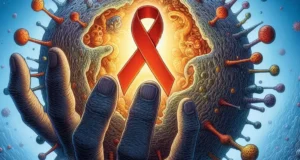In the vast theatre of global events, the media often acts as both the spotlight and the scriptwriter. When the world first whispered, then screamed, “AIDS — where did it come from?”, it was not science alone that answered. The camera lens, the news anchor’s voice, and the printed headlines shaped that answer long before any microscope could.

The villagers look to the skies and ask, “Where did this come from?” Before the meteorologist speaks, the rumors fly. The clouds darken not just with rain, but with fear. That’s what the early 1980s felt like when the first stories of a deadly new disease began to surface — mysterious, incurable, and relentless. And the media, like a loudspeaker in a windstorm, amplified both truth and terror.
quickly leapt from lab journals into living rooms. But instead of offering clarity, early media reports often painted the disease with a brush dipped in stigma. Headlines in bold fonts didn’t just report numbers — they screamed, “Gay Plague” and “Mysterious Illness Targets Homosexuals.” This narrative didn’t just misinform — it wounded.

In this tale, the media became both the storyteller and the sorcerer. It summoned fear from shadows and cast suspicion like spells. Television clips of emaciated men, print stories laced with moral judgment, and the repeated focus on certain groups — particularly gay men and drug users — framed AIDS not as a global health issue but as a punishment. As people kept asking, “AIDS — where did it come from?”, the media subtly whispered back, “From them.”
But media is a river — always flowing, and sometimes it learns to cleanse itself. Magic Johnson, a celebrated NBA star, announced he was HIV-positive and suddenly the world saw a new face of AIDS — strong, masculine, beloved. The media lens widened, and with it, the public perception softened.
Still, the question persisted: “AIDS — where did it come from?” This time, the answers weren’t found in judgmental headlines, but in documentaries, in scientific journals, in responsible reporting. Journalists started spotlighting the virus’s roots in simian immunodeficiency viruses, cross-species transmission, and the role of globalization and unsterile medical practices. The lens zoomed out from individuals to systems — from morality to biology.
Yet even in the modern era, the residue of early media coverage lingers like a watermark. The way a story is told in its first chapter often defines the emotional arc of the entire narrative. And for AIDS, the media’s early chapters were stained with fear, shame, and misinformation. We still see traces of it today — in hesitancy to get tested, in the quiet judgment some harbor, in the whispers rather than open conversations.
So now, when someone types into a search engine or asks in a classroom, “AIDS — where did it come from?”, we must remember that the answer is not only in genomes and antibodies but in headlines, broadcasts, and public memory. The media didn’t just document the epidemic — it participated in it. It held the mirror that shaped how the world saw the disease — and the people who lived with it.
In the end, media coverage of AIDS is a lesson in the power of narrative. It teaches us that how we tell a story can save lives — or cost them. And in the age of misinformation, where new pandemics may arise, this lesson is more vital than ever.




